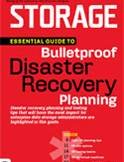Bulletproof your disaster recovery planning process
Learn how to bulletproof your disaster recovery planning process with this free guide.
 Developing a disaster recovery plan used to be a lot like taking out one of those hefty Lloyd’s of London insurance policies -- it might have given you some piece of mind, but it sure took a big chunk out of your budget. For years it was generally accepted that a DR plan was something that only well-heeled large enterprises could consider.
Developing a disaster recovery plan used to be a lot like taking out one of those hefty Lloyd’s of London insurance policies -- it might have given you some piece of mind, but it sure took a big chunk out of your budget. For years it was generally accepted that a DR plan was something that only well-heeled large enterprises could consider.
A decade of unexpected disasters -- both manmade and acts of nature -- have convinced most companies that having a disaster recovery planning process in place to help keep a business running in the face of adversity is less a luxury than good business sense. Fewer companies today rely on an up-to-date set of backups and crossed fingers to weather what could be business-crippling storms.
With greater awareness, companies of all sizes have realized how critical it is to have a DR plan in place, and many have given top priority to developing a plan. Still, disaster preparedness isn’t easy or free, and if you’re lucky you won’t ever really know just how effective your plan is.
Most IT pros are familiar with the general steps involved in the DR planning process: Potential risks must be identified, the key corporate systems that are vital to your company’s continuing operations must be identified, and the hardware and software infrastructure must be put in place to complete the safety net. But with each step along the way, there are a myriad of details that will arise along with easy to overlook interdependencies upon which success or failure may hinge.
But storage managers should be encouraged by recent technological developments that can make your disaster recovery planning process easier to put in place. Replication is often a key element of a DR plan, ensuring that key data is safely tucked away at a distant site and ready to be recovered. In the past, implementing replication often meant duplicating primary site storage systems at recovery sites -- an expense beyond the means of many companies. Today, there are many replication alternatives that obviate the need for mirrored configurations, and they cost far less than previous alternatives. And virtualized servers can also reduce the reliance on duplicate hardware resources and make recovery an easier, more agile process.
Despite the new technologies that can take some of the sting out of DR configurations, some aspects of DR planning haven’t changed all that much. Although there are some tools available that can assist, testing still remains a largely manual process -- and is the only way to confirm that all the planning, systems implementation and recovery drills will actually work.
For this guide, we asked top DR experts to address some of the key issues related to the disaster recovery planning process, including incorporating virtual server technology, recovery site options and, of course, testing. Whether you’re just embarking on DR planning or refining an existing plan, we think you’ll find their advice useful.
Here's a look inside this guide:
- Eight DR planning tips: Successful DR planning doesn't happen by accident. Improve your odds with these eight DR planning tips.
- Hot, warm and cold DR sites: DR terminology can be confusing. Terms like hot site, warm site and cold site are common in DR parlance. Each option can be a reliable disaster recovery site, but which one should you choose for your company? Here’s a look at the differences between hot, warm and cold sites in disaster recovery and the pros and cons of each.
- Disaster recovery testing basics: One of the fundamental prerequisites of successful DR planning is to understand the requirements of the business. What does the business need, and is it capable of addressing this need with regard to both capabilities and cost? The key performance metrics to support this are recovery time objective (RTO) and recovery point objective (RPO).
- Developing a disaster recovery plan for virtual machines: Virtual machine disaster recovery is a multifaceted activity that fails over a VM from a primary site to a remote location. Learn about the best approaches to facilitating disaster recovery in a virtual machine environment in this article.
Click here to download our guide on disaster recovery procedures.







